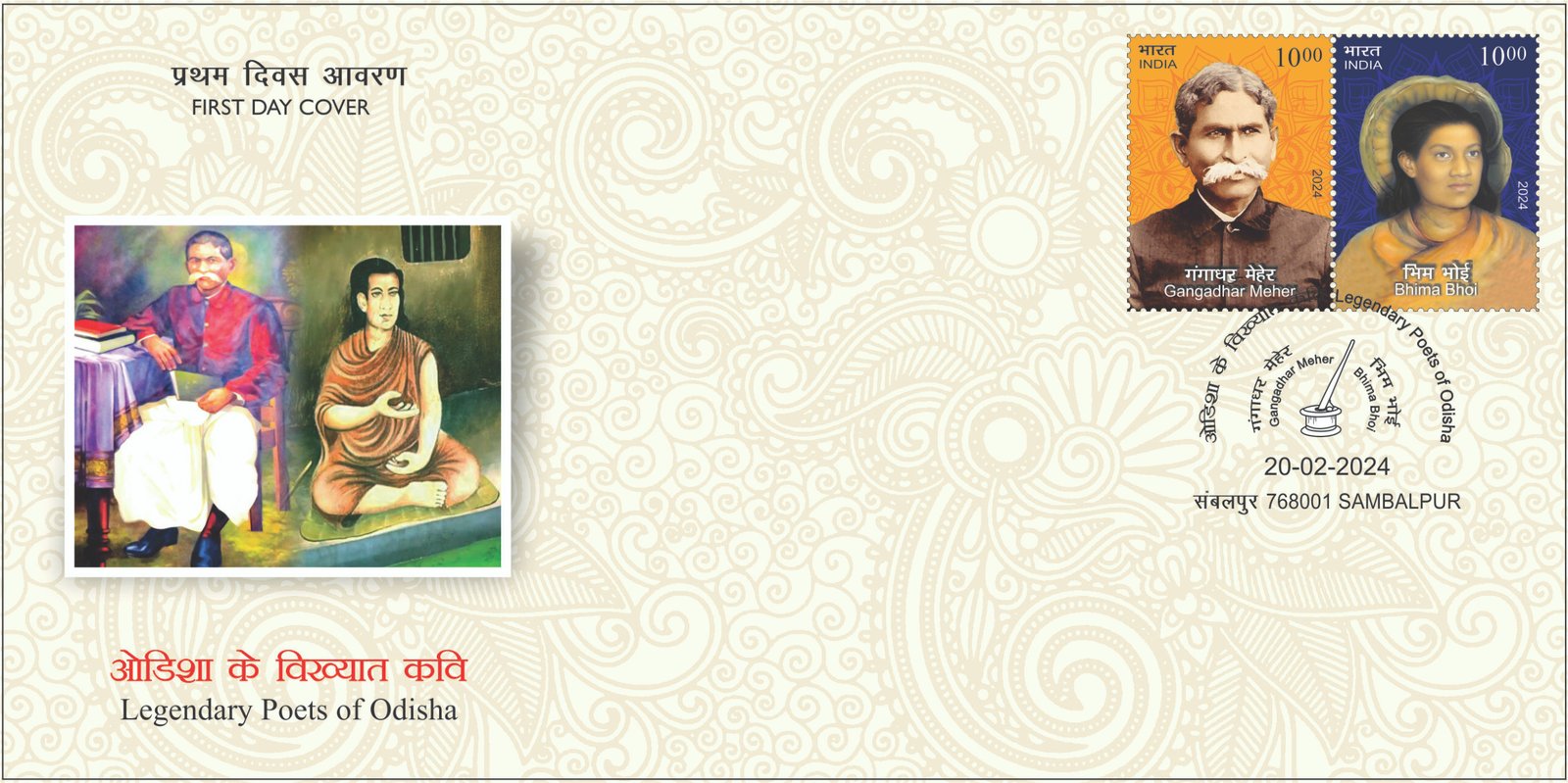Poets of Odisha

Technical Data
| Stamp Set | Poets of Odisha |
|---|---|
| Date of Issue | February 20, 2024 |
| Denomination | Rs. 20 |
| Quantity | 111,000 |
| Perforation | Harrow13½ |
| Printer | Security Printing Press, Hyderabad |
| Printing Process | Wet Offset |
| Watermark | No Watermark |
| Colors | Multicolor |
| Credit (Designed By) | Sh. Brahm Prakash |
| Catalog Codes |
Colnect codes IN 2024.02.20-03 Yvert et Tellier IN BF235 Stanley Gibbons IN MS3899 |
| Themes | Authors | Famous people | Literary People (Poets and Writers) | Literature | Men |
Honored in Philately – Santha Kabi Bhima Bhoi & Swabhaba Kavi Gangadhar Meher
The cultural heritage of Odisha is a rich blend of classical arts, temple architecture, devotional music, and profound literary traditions. Among its many unsung heroes, two figures shine with unmatched brilliance Santha Kabi Bhima Bhoi and Swabhaba Kavi Gangadhar Meher. Their literary genius and spiritual depth left an indelible mark on Odia literature and culture. Today, their legacies live on not only through their works but also through the Legendary Poets of Odisha Stamp Series, a philatelic tribute to their timeless contributions.
Santha Kabi Bhima Bhoi – The Mystic Saint-Poet
Born around 1850, Bhima Bhoi remains one of Odisha’s most enigmatic spiritual poets. Details about his life—his exact birth date, birthplace, or death—are shrouded in mystery. Yet, his writings and his role as a tribal saint, philosopher, and reformer speak volumes about his extraordinary life.
According to legend, Bhima Bhoi worked as a cowherd before he encountered Mahima Gosain, who inspired him to spread the message of Satya Mahima Dharma. This movement emphasized renunciation, non-attachment, and spiritual equality. At a time when society was deeply divided, Bhima Bhoi gave voice to the downtrodden and offered them dignity and faith. His efforts also curbed conversions to Christianity, ensuring people could find reform and refuge within their own traditions.
Bhima Bhoi’s literary works include Brahma Nirupana Gita, Stuti Chintamani, Astaka Bihari Gita, Chautisa Madhu Chakra, and Bhajanamala. His verses, composed in Odia (Kosali) and Bengali, are celebrated for their lyrical devotion and philosophical depth. His immortal lines—
“Praninka arata, dukha apramita dekhu dekhu keba sahu, mo jibana pachhe narke padithau, jagata udhhara heu” resonate across time, finding a place on the walls of the United Nations Headquarters and the Indian Parliament.
Bhima Bhoi passed away in 1895 at Khaliapali, where his Samadhi Temple stands as a place of reverence. Today, devotees worship him alongside Maa Annapurna, honoring him as both saint and poet.
The Bhima Bhoi Stamp immortalizes this mystic poet, allowing philatelists to preserve and celebrate his revolutionary contribution to Odisha’s cultural and spiritual heritage.
Swabhaba Kavi Gangadhar Meher – The People’s Poet
Another towering figure of Odia literature, Gangadhar Meher, was born on 9th August 1862 in Barapalli, Bargarh district. Coming from a humble weaver family, his childhood was marked by hardship and limited education. Yet, his determination led him to study texts like the Raghuvamsham and Tulasi Ramayana, while balancing weaving duties at home.
Recognized for his integrity and literary talent, he found employment as an Amin (Patwari) and later as a Moharir under the local Zamindar. Despite modest means, his passion for writing never waned. His early work Rasa Ratnakara followed classical Odia styles, but he soon embraced modern literary forms, producing verses filled with imagination, lyrical rhythm, and vivid descriptions of nature.
His celebrated works include Pranaya Ballari, Kichaka Badh, Indumati, Utkal Laxmi, Ayodhya Drusya, Kavita Kallola, and Krushaka Sangita. His prose contributions, such as Atma Jeevani and Purana Kavi Fakir Mohan, further enriched Odia literature. Like Upendra Bhanja, whom he admired, his writing style was marked by ornamental language, metaphors, and musicality.
Gangadhar Meher passed away on 4th April 1924, leaving behind a literary treasure that continues to inspire scholars and readers alike. The Gangadhar Meher Stamp celebrates his role as Odisha’s “Swabhaba Kavi” (Poet of Nature), keeping his legacy alive for future generations.
Philatelic Tribute to Odisha’s Poetic Heritage
By issuing the Legendary Poets of Odisha Miniature Sheet, the Department of Posts has honored the unparalleled contributions of Bhima Bhoi and Gangadhar Meher. For philatelists, these stamps are not just collectibles but cultural milestones—reminders of the enduring power of poetry to inspire, reform, and uplift society.
As India journeys through the Amrit Kaal, these philatelic tributes reaffirm the timeless relevance of Odisha’s literary icons, encouraging the youth to take pride in their heritage and to cherish the values of devotion, imagination, and reform.
First Day Cover

